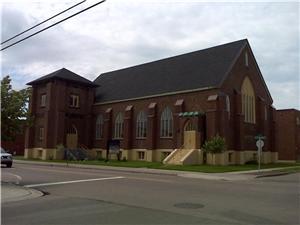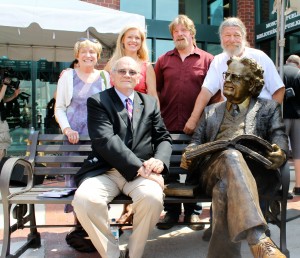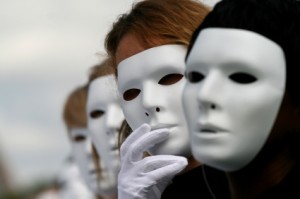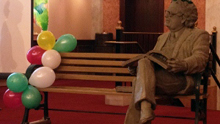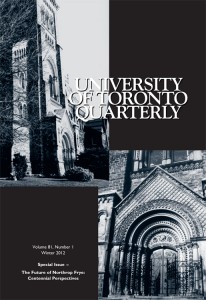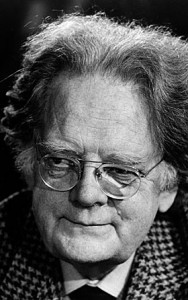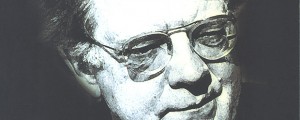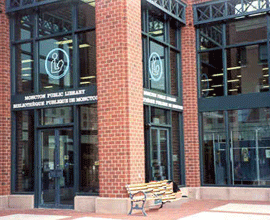
Northrop Frye and Public Libraries
Robert D. Denham
Moncton Public Library, Moncton, New Brunswick, 13 July 2012
As Northrop Frye devoted his life to the word, it goes without saying that he had great affection for those wonderful repositories of the word that we call libraries. But for all of the connections between Frye and academic libraries, he had a special fondness for the public library.
During the summer of 1930, after his first year at Victoria College, Frye got a job pasting labels into books at the Toronto Reference Library––which was a public library, not a university one. It was here that he discovered––“by accident” he says––Colin Still’s book on The Tempest, a book that significantly influenced Frye’s reading of Shakespeare. Two years later (Frye is 19 at the time), he returned to Moncton for the summer, taking the two-day journey by way of Montreal. He was able to land a job at the public library, which had opened in 1927 in what became known as the “Archibald House” at the foot of Archibald Street.
In the summer of 1932 Frye was not altogether happy about being back home: he had become separated from the Toronto he’d grown to like, from his classmates, and of course from his girlfriend Helen Kemp. But his discontent is mitigated somewhat by his being close to the books he loved. In the Moncton library he discovered Louis Untermeyer’s American Poetry since 1900, a book that was to introduce him to Wallace Stevens, who turned out to be one of Frye’s literary heroes.
Frye wrote in a letter from that summer, “I rather like working in this library. It’s such an interesting psychological study. The number of ways a taxpayer can think up to bully me are practically infinite. There’s one charming old gentleman who comes in about three times a week, tosses disgustedly a couple of detective stories in front of me and says: ‘Trash, absolute trash! Got any more of that author?’ Then he explains shamefacedly that he uses them as soporifics. Then there are French youngsters who suddenly become most hopelessly ignorant of English whenever they have a fine due on their books.”
During the summer of 1936 Frye checked out two volumes of Frazer’s The Golden Bough from the Moncton Public Library, and Frazer became, of course, one of the key sources for Frye’s understanding of myth and ritual. In the early 1950s when Frye was at Harvard on a Guggenheim Fellowship he had at his disposal, of course, the famous libraries at Harvard, but one of the first things he and Helen did was to get cards from the Cambridge Public Library. And even though in Toronto he had access to one of the great university libraries in the world, he patronized the Deer Park Library, a public library on St. Clair Avenue.
When I first talked to Dawn Arnold and Tina Bourgeois about donating my Frye collection to the Moncton Public Library I had in mind that it might serve as a kind of monument to Frye’s achievement. I didn’t think of it as becoming much of a research center. At the heart of the collection are the various editions and translations of Frye’s books. There are 114 translations in 25 languages. It seemed very unlikely that researchers would travel to Moncton to read Frye in Farsi or Lithuanian or Arabic, or even any of the 21 translations of Frye into Italian. In other words, I saw Frye’s books and his writing desk and the drawings and caricatures and paintings as belonging more to the holdings of a museum than a library. But then I asked whether the library might be interested in the secondary literature––the books and articles written about Frye, the reviews of his books, and so on. When the answer was yes, then I began to think that the Moncton Public Library might well become a destination for those interested in Frye’s work. If some researcher, for example, were interested in the reception of The Great Code, he or she would want to consult the almost 200 reviews of that book. It would require a great deal of time to dig all of these out from a research library, or rather research libraries, since no one library, including the National Library of Canada, would have them all. But now here they all are in Moncton––photocopies of all of the reviews of The Great Code. Or take the books devoted exclusively to Frye’s work. There are 46 of these. Researchers wanting to consult what is written about Frye might set off for the libraries of the University of New Brunswick, where they would discover 28 of the 46. But now, why not come to Moncton where they’ll find all but one of these books––98% rather than the 60% they’d find in Fredericton and Saint John?
We do make a distinction between public and research libraries. I myself have done a great deal of research in public libraries, the Toronto Reference Library, which is the centerpiece of the Toronto Public Library system, being a notable example. Frye himself liked to go to the Toronto Reference Library because, as he says in his diaries, it was “clear of [his] environment,” that is, it provided a momentary refuge from the university. It was in the Toronto Public Reference Library that Frye read The Tibetan Book of the Dead and Jung’s Secret of the Golden Flower. It was also in this public library that he began to write Anatomy of Criticism, the greatest work of critical theory of the last century.
In his 1950 Diary Frye reports that on a trip to London, Ontario, friends drove him and Helen to see what he calls “the famous public library,” noting that the public library was “also an art gallery, a film & record library, & a community center generally. It is a most pleasant little building, & I’d have liked to see more of it.” Here Frye is getting at one difference between the academic and the public library. Academic libraries tend to be detached and impersonal and sometimes not very user friendly. Public libraries, on the other hand, are the focus of a community. I like to think that having the Frye papers here at the Moncton Public Library will help to foster that sense of community.
I wouldn’t expect that there will be a long queue next week of people elbowing their way into the Frye Collection, but it could be that over time the Collection will serve as a magnet to draw Frye scholars and others to the library. Moncton may not yet have a Northrop Frye Street, as Sherbrooke, Quebec, does, but it does have its Northrop Frye School and its terrific Northrop Frye Festival and now a Northrop Frye sculpture and a collection of Northrop Frye books and papers and other Frygiana––all of which serve to honor the city’s most famous son, the one who Don Harron says possessed “the finest literary mind in the Western world.”
I should say how pleased I am that the Frye Collection is now in Moncton, and to say what a pleasure it has been to working with Dawn Arnold and Danielle LeBlanc of the Frye Festival, and with the library representative, Tina Bourgeois, and with my old friend Ed Lemond who spent five days in Emory, Virginia, appraising the collection. And thanks too to Léon Cormier and Victor Gautreau who hauled it all safely across the border. Everyone I’ve worked with has been a model of efficiency and, like Frye himself, supplied with a generous measure of good will.
As it’s a great deal more fun to hear Frye talk rather than me, let me close with the opening of a letter to Helen written exactly eighty years ago, on Frye’s twentieth birthday:
My dear Helen:
I have recently completed another decade of my alleged career and feel quite old-fashioned. My birthday, which is the same as that of France, has been signalized by a pouring rain on the last sixteen occasions of its celebration, which is as far back as my memory—or at least the pre-Freudian part of it—goes. This time the day dawned clear as a mirror; no vestige of a cloud anywhere. It stayed that way until eight o’clock at night, when suddenly and without warning a horrible-looking black thundercloud leered up over the horizon, like the devil coming for the soul of Faust, and for an hour the world was a stringy mass of water. I got a present too—a tie, from an aunt. I shall keep it as a souvenir of that aunt, but as an adornment for the neck it would rank approximately with the Ancient Mariner’s albatross, I should think.
Kind thanks for inviting me to Moncton on this grand occasion.
